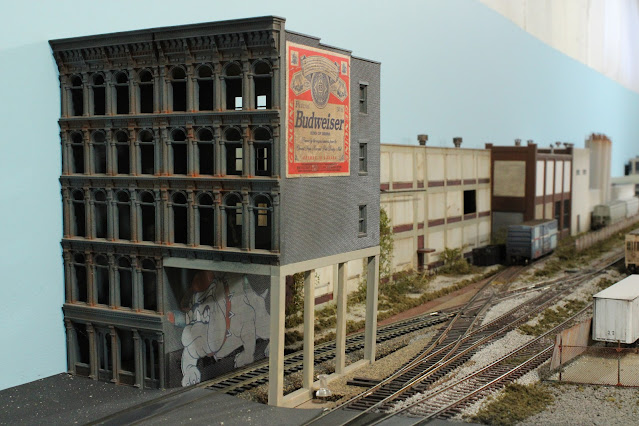I've had a Walthers gondola for many years that I very rarely had out on the layout here. In my recent gondola craze, I had an idea for this one and brought it out of the cupboard and over to the workbench. The gondola was green and lettered for MKT in yellow. You'll have to just take my word for that, because I didn't take pictures of it.
I laid a piece of .005 styrene sheet down on the road in front of our house as I've described before and ran an old wallpaper seam roller overtop of it, sort of embossing the little bumps from the asphalt into the styrene. That styrene was then cut into pieces to fit over the side panels of the gondola.
I had noticed that on-line photos of many GTW gondolas showed that the blue appeared to be quite faded. To get the faded the blue colour, I pre-mixed C&O Blue with Concrete Gray and sprayed the car with my airbrush, then added a GT logo and reporting marks decals.
The wheels on my model are metal replacements, and the couplers are Kadee.
I can't honestly say one way or the other if GTW actually has or had any Greenville gondolas, but the GTW here in the basement has one now and I think that this gondola will look right at home. I did however use a prototype reporting mark number, GTW 148099.
Not the greatest photo, as you can only slightly make out just a few of the bulges on the side panels, but here it is repainted and re-lettered.
And below is how things stand a couple days later after some graffiti, plus the grime and rust has been added. Some of the graffiti is decals and some is hand scribbled by me.
Burnt umber artist paint, a few old brushes, etc. I know the weathering on the car might look a little overdone to some, but when on the layout, I'm sure this gondola will blend right in and look like it belongs.
The interior of the gondola became quite rusty with the use of a nifty craft store product called Metal Effects - Rust. Perfect for this particular application.
At the bottom of the photo is the removable load that I've made for the gondola. A piece of .040 styrene that I cut to size is painted brown and then metal chips from a milling machine are glued on top of it. The load can be dropped right in or popped right out to become an empty gondola again.
The loaded gondola and a small pile of spare metal chips that I'll save for use another time.
Below is a view of my gondola, spotted now at the metals recycler...
And loaded...The faded blue gondola covered in grime and graffiti and the gondola fits right in with the surroundings.

Looks like it's suffered long years of use and abuse. I'm just missing uncoupler bars, and perhaps air hoses, but this makes a real nice addition to my fleet of gondolas.






.JPG)















